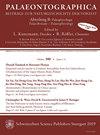早期被子植物及其传粉者的共同进化:来自花粉的证据
IF 1.6
3区 地球科学
Q2 Earth and Planetary Sciences
Palaeontographica Abteilung B-Palaeophytologie Palaeobotany-Palaeophytology
Pub Date : 2010-10-04
DOI:10.1127/PALB/283/2010/103
引用次数: 16
摘要
在被子植物中,花粉形态传统上被用来区分风传粉和动物传粉。此外,关于白垩纪被子植物花粉团可能有植物或动物起源的文献越来越多。现代传粉生物学研究认为,花粉在花中结块的进化与昆虫传粉有关,粘稠花粉可能起源于被子植物。对食花粉昆虫粪便的研究表明,含花粉的粪化石(化石昆虫粪便颗粒)可能提供有关食用花粉的生物和潜在传粉者身份的信息。本文对美国阿普tian至坎帕尼亚地层的分散花粉样本进行了初步研究,以研究基于分散花粉的传粉模式的频率,并追踪花粉团的存在。我们建立了区分花花粉团和含花粉粪化石的标准,表明化石花花粉团形状不规则,表面粗糙,由单一种保存完好的颗粒组成,而含花粉粪化石形状规则,表面光滑,含有损坏的颗粒。关于花粉传播频率的初步数据支持了之前的假设,即早白垩纪被子植物是昆虫传粉的,而风传粉在晚白垩纪中期变得重要。这些花粉数据也支持了一种观点,即动物和风的两栖授粉可能在早期就存在了。花花粉团很少出现,直到白垩纪中期。团块的时间分布表明,早期花朵的花粉不粘,这种粘可能是为了适应更高级的传粉者而进化的。含花粉的粪化石在整个白垩纪都有发现,它们的整体形态各不相同,保存的单个颗粒也各不相同。根据先前对昆虫起源的含花粉粪化石的研究,昆虫的一些消化策略似乎与鞘翅目、双翅目和膜翅目昆虫的消化策略相似,在中生代晚期就已经存在了。本文章由计算机程序翻译,如有差异,请以英文原文为准。
Coevolution of early angiosperms and their pollinators: Evidence from pollen
Pollen morphology has traditionally been used to distinguish wind from animal pollination in angiosperms. In addition, the body of literature on Cretaceous angiosperm pollen clumps that may have had either a botanical or zoological origin is growing. Modern pollination biology studies suggest that the evolution of pollen clumping in flowers, resulting in floral pollen clumps, is attributable to insect pollination and that sticky pollen may be ancestral in angiosperms. The study of feces from pollen-eating insects suggests that pollen-containing coprolites (fossil insect fecal pellets) may provide information on both the organisms consuming the pollen and the identity of potential pollinators. We present here a preliminary study on dispersed pollen samples from Aptian to Campanian strata in the U.S.A. to examine the frequency of pollination modes based on dispersed pollen and to track the presence of pollen clumps. Criteria were developed to distinguish between floral pollen clumps and pollen-containing coprolites that show that fossil floral pollen clumps are irregularly shaped with rough surfaces and are composed of a single species of well-preserved grains, while the pollen-containing coprolites are regularly shaped with smooth surfaces and contain damaged grains. The preliminary data on the frequency of dispersed pollen support previous hypotheses that the Early Cretaceous angiosperms were insect-pollinated and that wind pollination became important later during the mid-Cretaceous. These pollen data also support the idea that ambophilous pollination, by both animals and wind, may have also existed early on. Floral pollen clumps appear only rarely until the mid-Cretaceous. The temporal distribution of clumps suggests that the pollen from early flowers were not sticky and that stickiness may have evolved with an adaptation to more advanced pollinators. Pollen-containing coprolites are found throughout the Cretaceous and vary in overall form, as well as in the preservation of individual grains. Based on previous studies of pollen-containing coprolites of insect origin, it seems likely that a number of insect digestive strategies, similar to those found in living members of Coleoptera, Diptera, and Hymenoptera were already in place by the late Mesozoic.
求助全文
通过发布文献求助,成功后即可免费获取论文全文。
去求助
来源期刊
CiteScore
3.90
自引率
0.00%
发文量
1
审稿时长
>12 weeks
期刊介绍:
Section B of Palaeontographica publishes contributions to palaeobotany, i.e. papers on morphological traits, systematics and phylogenetic features of plants as well as papers on palaeoclimatology and palynogeography. Especially worth mentioning are the comprehensive monographs published in Palaeontographica B on specific floras or plant groups. Often palaeoclimatic or stratigraphic problems are clarified by resorting to palaeobotanical data published in Section B of Palaeontographica.
Throughout the last decades, numerous objects important to palaeophytology have been found in many places all over the world. As Palaeontographica publishes papers on floras on any parts of the world to report world-wide research, contributions in German, English and French have been published since the beginning of the journal, today English language publications are preferred.
Palaeontographica B is of interest to palaeobotanists, palynologists, palaeoclimatologists, stratigraphers and the libraries of all institutions engaging in such research.

 求助内容:
求助内容: 应助结果提醒方式:
应助结果提醒方式:


